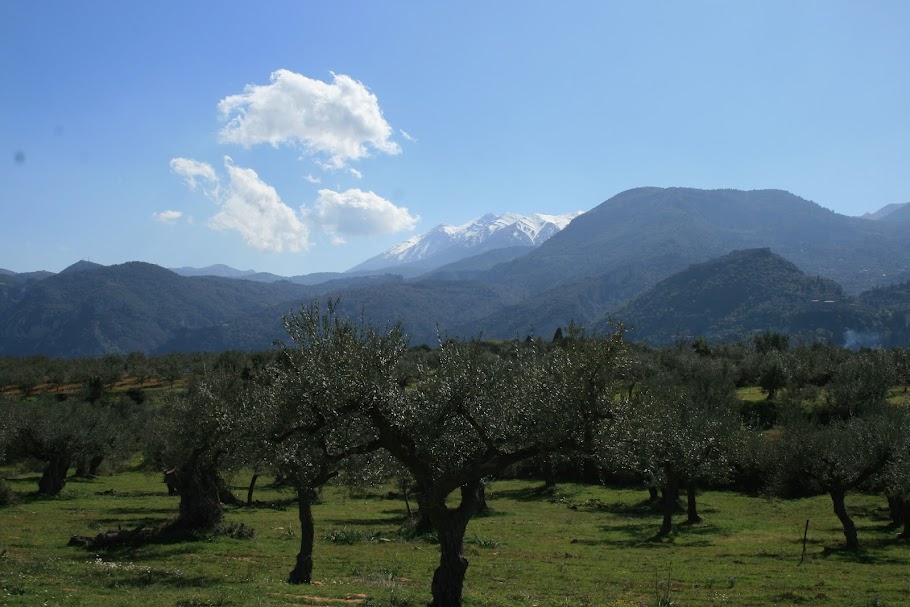One of the ugliest aspects of ancient Sparta to capture the modern imagination is the idea of “unworthy” infants being tossed off a precipitous cliff to their death by cold-hearted elders. I recently stumbled across another blog where the outraged comments about this custom far outweighed all other comments about the “weird” Spartans.
The
tradition of Spartan infanticide has its roots in Plutarch, who
specifically describes this cruel custom (Lycurgus: 16), but I
personally have number problems with the way the custom is handled in
modern literature.
 |
| Taygetos -- the moutains behind Sparta |
First,
of course, is the simple fact that the alleged site of these murders on
Taygetos has indeed revealed many skeletons – but only of adult males
not infants. In short, there appears to be some truth to the notion that
people were executed by being thrown off a particular cliff, but no
evidence whatever that infants were killed in this way. That said, the
actual method of murder is a more-or-less irrelevant detail; the issue
is the systematic murder of infants deemed unlikely to grow up healthy
and hardy enough to survive the agoge and be good hoplites.
My
second problem with Plutarch’s account is King Agesilaus II. Agesilaus
was King Agis’s brother, and allegedly attended the agoge because he was
not heir apparent. He was also “lame.” So how did an infant that was
lame and not the heir apparent to the throne avoid being murdered as an
infant and survive the agoge? Did his lameness develop later? Possibly,
but the historical record makes no reference to an accident or injury.
It appears that at least by the late 5th century the definition of
“unworthy” could be very subjective and even lameness was not
necessarily grounds for elimination.
Still,
neither the lack of infant skeletons nor the singular case of Agesilas
II actually refute or disprove Plutarch either. So we must admit the
possibility that he is correct. Nevertheless, I still have a major
problem with the modern discussion of Sparta’s policy, and it is the
lack of context.
Most
ancient Greek families were small. We do not hear of families with
dozens of children as in the Middle Ages. Contemporary literature from
comic opera to court documents make the notion of widespread sexual
abstinence an unlikely explanation of the low birthrates. On the
contrary, despite the ready availability of slaves, prostitutes and
concubines, Greek literature, comedy, philosophy and legal proceedings
assume frequent sexual contact between men and their wives. Birth
control therefore had to come from contraception or infanticide. The
documentary evidence is that infanticide in the form of abortions and
exposure of unwanted infants after birth were the only effective
contraceptive known in ancient Greece.
Historians
hypothesize that at a woman in ancient Greece would have borne on
average 4 to 6 children – and watched 2 to 4 of them die either due to
intentional exposure or due to neglect. Most of those neglected/murdered
infants would have been female because ancient Greek society was
misogynous. Women were considered mentally and physically inferior to
men, and they were a financial burden because they required dowries. In
societies today with similar attitudes (Afghanistan, Pakistan, India,
east Africa, traditional China), female fetuses are more likely to be
aborted, and female infants are more likely to die of neglect. It is
estimated that 2 million female infants die each year because they are
unwanted. The Greek comic poet Posidippus put it this way: “Everybody
raises a son even if he is poor, but exposes a daughter even if he is
rich.”
In
short, exposing unwanted children was a common (not to say universal)
practice in ancient Greece. What shocked male commentators from the rest
of Greece about the Spartan practice was that 1) it applied to males
rather than (worthless) females, and 2) it was left to the state (elders
of the tribe) rather than the father to decide a infant’s fate. It was
not the fact of murdering children that other Greeks found offensive,
but the fact that a father did not have absolute control over the fate
of his sons. In Sparta and Sparta alone, an outsider (a tribal elder)
could interfere in a father’s despotic control over his own family.
None
of this makes the Spartan practice of murdering “unworthy” infants more
palatable. It is and remains an aspect of Spartan society that I too
find alienating. But I would welcome more recognition of the fact that
infanticide was not one of the aspects of Spartan society that made it
“weird” and different from the rest of Greece. Infanticide was the norm
throughout ancient Greece – including in “enlightened” Athens.
The Sparta of my novels reflects the above reality rather than the artificial brutality of most modern writers. Read:
Buy Now! Buy Now! Buy Now!
The Sparta of my novels reflects the above reality rather than the artificial brutality of most modern writers. Read:
Buy Now! Buy Now! Buy Now!






